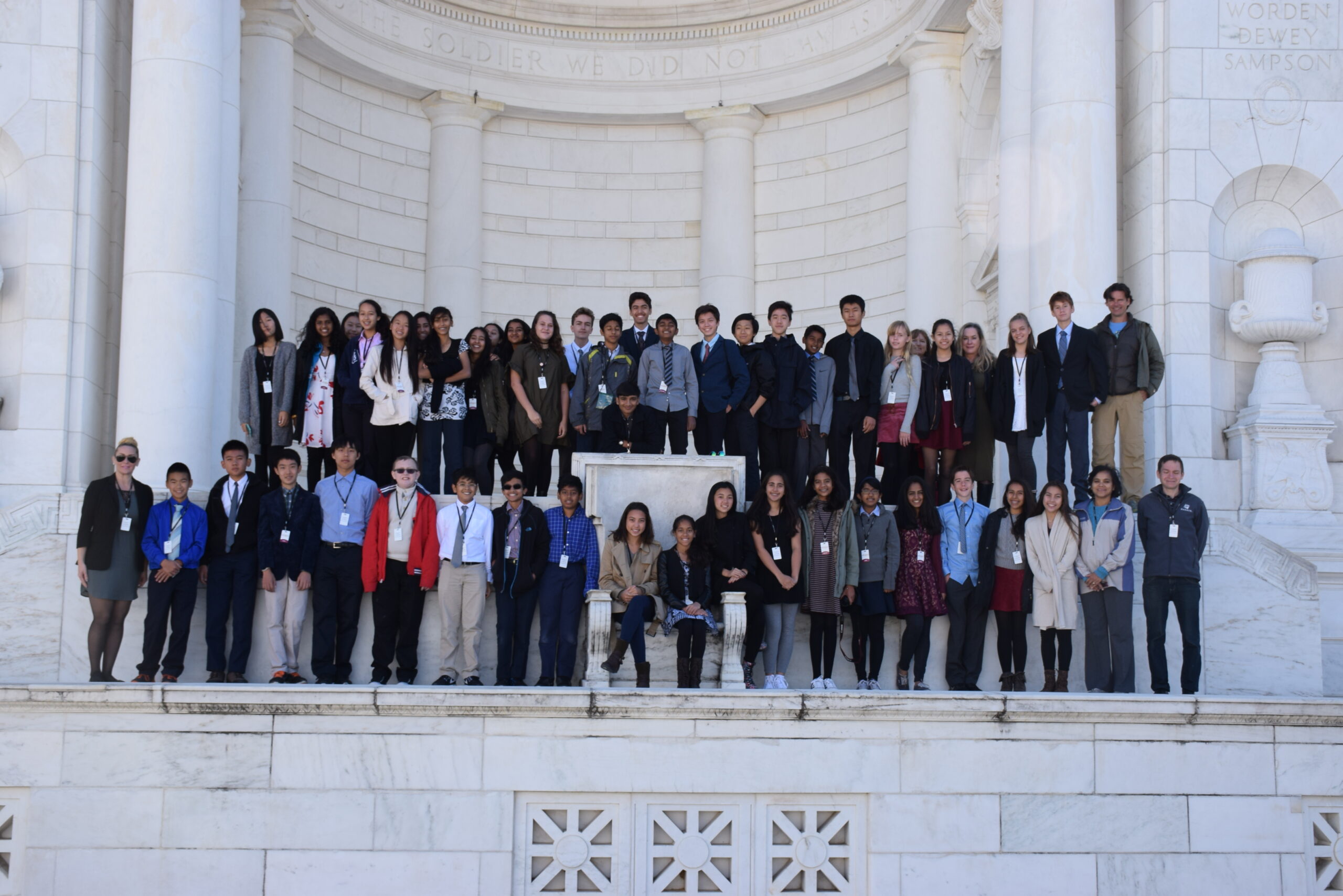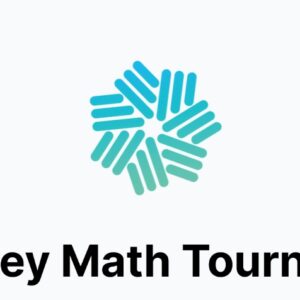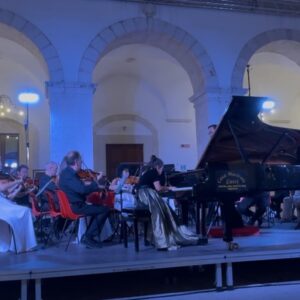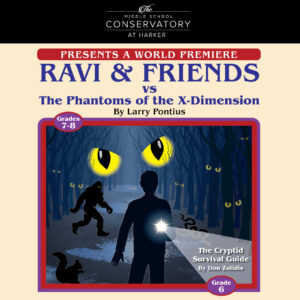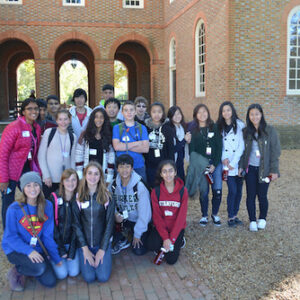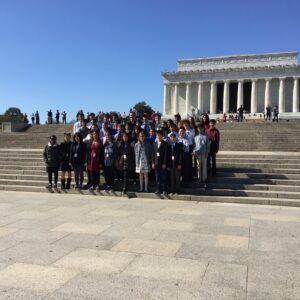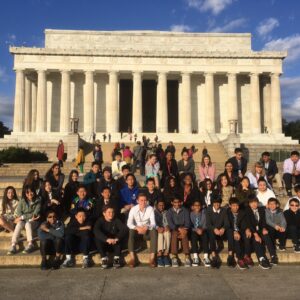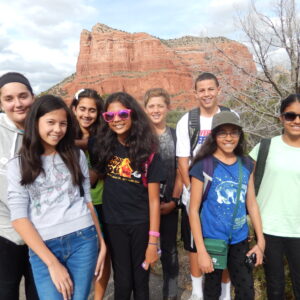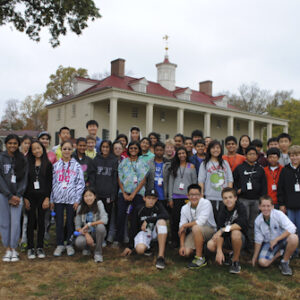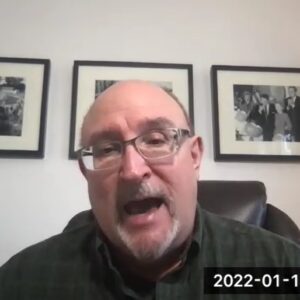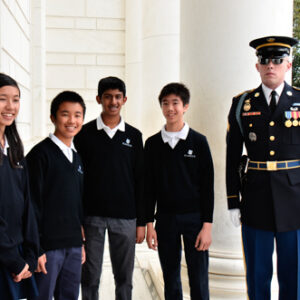Grade 8 students spent the week of Oct. 24-28 traveling through the Washington, D.C., area, getting an up-close look at many of the United States’ most historic sites. Assistant head of school Jennifer Gargano chronicled the daily travels of the students, and we updated this story as they came in.
Day 5: The Capitol, Library of Congress, National Archives and Supreme Court
We began the day taking a group photo in front of the Capitol building, an eighth grade trip tradition. We then took part in an informative, guided tour of the Capitol building. We saw the two statues, that of Ronald Reagan and Saint (Father) Junipero Serra, donated by the State of California to the National Statuary Hall Collection. I was with bus three for this visit and their Capitol gallery tour guide was part comedian, part guide. As such, the students were engaged, learning and laughing, as they heard about the history and architecture of the Capitol.
We then sat in the gallery of the House of Representatives while our Academic Expeditions bus guide explained how a House session and vote usually proceeds. After, we participated in a self-guided tour of the Library of Congress. Some of our avid readers were excited to visit the largest library in the world and were surprised to hear that there was a librarian of congress. Since there is a “flame of knowledge” atop the Library of Congress, the students on some of the buses suggested we sing “The Harker School Song” during our bus ride. It was wonderful to hear those lyrics on the bus.
Later, during our quick visit to the National Archives, the students were able to view the original copies of the three main formative documents of the U.S. government: the Declaration of Independence, the Constitution and the Bill of Rights.
While at the Supreme Court, a docent gave us a very thorough presentation about the judicial branch. Many students commented how odd it was to only see eight seats at the Supreme Court. Our students were wonderful about answering the various questions the docent posed about all three branches of government.
The students of course enjoyed the dinner and dance cruise at the end of the day. Having all of the eighth graders together, singing and dancing was a great way to spend our last evening of the trip. My favorite part was seeing all of the eighth graders singing and motioning to YMCA, a song all the students are familiar with.
It has been a wonderful week. During this week, we learned that some students had personal connections to the various sites we visited. While some of the stories, such as those related to a relative’s involvement in a war, could be sad at times, the visits gave the students an opportunity to speak to their families about the connection and then share those connections and stories with their peers. It provided even more learning opportunities.
Our Academic Expedition guides – Tracy (bus one), Terry (bus two), Daniel (bus three) and Isaiah (bus four) – mentioned this evening how much they enjoyed the time with our students and can’t believe the week is already over. They too had bonded with our students. Tomorrow, students will see the White House, the new African-American museum, and the Smithsonian Museums their bus group did not yet get a chance to visit.
Day 4: Ford’s Theatre, Newseum and Holocaust Memorial Museum
Today, we visited Ford’s Theatre where President Lincoln was shot. As with all the locations we visit, our Academic Expeditions guides provided the students with the history and information needed to contextualize what they saw. We also walked through the Petersen House, the house across the street from Ford’s Theatre where President Lincoln died after being shot the previous evening. The students asked particularly thoughtful questions of our AE guides. We were lucky to have Nurse Nott there to add some texture to the medical-related questions students asked about President Lincoln’s death.
The students also visited the Newseum. The Newseum is an interactive museum of news and journalism that also highlights the evolving role media has played in our history and how it has affected many world events. They have an educational movie call “I-Witness: A 4-D Time Travel Adventure,” recreating a variety of significant events in journalism history. It is in 3-D and contains fourth-dimension special effects that helps take the students on a journalistic trip through time. I spoke to a number of students about the Newseum and they seemed to particularly enjoy the 4-D movie, the Pulitzer Prize Photographs Gallery, the compilation of 9/11 news coverage and the exhibit “First Dogs: American Presidents and Their Pets.”
We also explored the Holocaust Memorial Museum. I was impressed by how the students approached this very serious and informative memorial museum. I accompanied bus four for this stop and one student asked to address her peers on the bus after the museum visit. She spoke about how impressed she was with her peers. She was proud to be a part of a school where the students gave the respect necessary for this type of memorial museum. She was also proud of how they approached the experience with a desire to learn. She then spoke to the students about what she read about in the Holocaust museum regarding the hope one survivor had in the midst of his very difficult experience. She urged her fellow students to not only have hope but to have the courage to change injustice in the world since there is always hope for change. The chaperones could not have been prouder at that moment. I observed all buses exhibiting high levels of respect and a great desire to learn. Having the opportunity to spend time with students so informed, kind and respectful reminds the chaperones of how lucky we are to work with Harker students.
After dinner, the students explored the memorials their bus groups did not visit yet. I continue to be impressed by the quality of the presentations the students are giving about the site they researched. They often share a fact about a given site that the AE guides and the chaperones were previously unaware of.
Day 3: Arlington National Cemetery, Alexandria and Mount Vernon
We have had really wonderful weather in Washington, D.C., thus far. Today was no exception. It has been fairly warm for D.C. We began our day in a very solemn way, visiting the Arlington National Cemetery where we saw the eternal flame of the Kennedy grave site and a few significant headstones. The highlight, of course, was watching the changing of the guard at the Tomb of the Unknown Soldier, followed by the laying of the wreath ceremony. We were very proud of Jason, Elizabeth, Arusha and Arjun, our student council officers, for laying a wreath inscribed with “The Harker School” at the tomb during this ceremony. After, all of the buses went to the Iwo Jima U.S. Marine Corps War Memorial.
We visited Old Town Alexandria for lunch. We then proceeded to Mount Vernon, the home and plantation of George and Martha Washington. We visited the mansion, the residence that George Washington’s father built in 1735 and George Washington expanded to its current 21-room size with bright wall colors and intricate architectural details. We also saw Washington’s tomb and toured the education center that traces Washington’s life story through art gallery displays and videos. Most notably, the education center features a multimedia 15-minute video detailing George Washington’s life as a general. To illustrate the cold winters during some battles, it actually lightly snows for a brief period. The 4-D aspects of that movie was a surprise and treat for our students.
After dinner at Buca di Beppo, we watched “Sheer Madness” at The John F. Kennedy Center for the Performing Arts, the busiest performing arts center in the United States. “Sheer Madness” is an interactive comical play with improvisational aspects where the audience is given an opportunity to solve a crime. Since the audience is involved, a unique performance is delivered each night. The students found it quite humorous to say the least.
Day Two: Pamplin Park and a very special meeting
What a first day in D.C.! We learned so much and met some amazing individuals.
We began our day at Pamplin Park, one of America’s best-preserved battlefields. The students first went to a Civil War museum on the Pamplin Park grounds, where they learned, via an audio guided tour, about the living conditions of soldiers as well as about the lives of a few specific soldiers who fought in the Civil War. We then visited Tutor plantation, the house that was home to the Boisseau family, ancestors of the Pamplins, and during the Civil War was used as the headquarters of a Confederate general. The plantation features a reconstructed working kitchen and slave quarters; learning more about the lives of the slaves on this plantation proved to be a wonderful way to further and solidify what the students learned last evening at the African-American music program. Students ended their time at Pamplin Park by participating in military drills and visiting the park’s recreated military encampment, where students were able to experience elements of a common soldier’s life.
Once we departed from Pamplin Park, we visited the National Museum of the Marine Corps on our way to D.C. The museum contains many Marine artifacts including the second American flag raised over Iwo Jima’s Mount Suribachi.
I accompanied bus one today and was able to hear many student presentations on the bus. As many of you may know, the eighth grade history teachers had each of the students briefly research one of the sites we will visit. Prior to each visit, a student reports on that site. I have spoken to many students who are excited about visiting the specific site they researched.
The highlight of the day for many students was our dinner at the Capitol Hill Club. After dinner, we celebrated our three birthdays. We brought Emma-Leigh Stoll, Karina Chen and Chance Hewitt to the front of the room, sang each a birthday song, and presented them with a dessert with candle so they could make a wish. It was a fun way as an eighth grade class to end our dinner. We then had the privilege of hearing presentations from Dr. DJ Patil, the United States’ first chief data scientist at the White House Office of Science and Technology Policy, and Maheen Kaleem ’03, human rights advocate and Harker alumnus. While both speakers do very different things, their themes were similar: Use the skills and knowledge you gain from your Harker education to positively impact the world. Both spoke about service to others and having the courage to do what is right.
Eighth grader Anna Arnaudova introduced Ms. Kaleem. Ms. Kaleem, a lawyer and social advocate, currently has a position at the Human Rights Project for Girls, where she is working with federal policy related to improving the juvenile justice system’s treatment and response to girls, with a specific focus on domestic minor trafficking. She also co-founded Pennsylvania Lawyers for Youth. Ms. Kaleem encouraged the students to respectfully stand up for what they believe and to explore their goals and values. She told the students that what will take them far in life is being the kind of person others trust, who follows through on promises and works hard, and who is believed to be generally good. While the skills she learned at Harker and the universities she attended allowed her to become a lawyer, it was those personal qualities that she believes led her to her specific path of helping so many young girls and woman. The students then had an opportunity to ask Maheen questions. Many students asked her about her work as well as about her experiences at Harker.
Eighth grader Rosh Roy then introduced Dr. Patil. Dr. Patil spoke about what he does in his role as chief data scientist. Like Maheen, he also gave our students many important messages that I know students will be reflecting on during the trip and hopefully throughout their lives. He spoke about having the courage to do what is right and to serve others. Dr. Patil emphasized that these students will be the next leaders and it will be important for them to be educated, to embrace the future, and positively impact the lives of all people. He admitted that is not always easy to do, but it is important work. Dr. Patil was extremely generous with his time and allowed the students to ask many questions. Our students asked many thoughtful questions about Dr. Patil’s role and in some cases, asked him to expand upon the topics and ideas he spoke about during his opening remarks. His stories about his work at the White House captivated the students and his message about the importance of public service was well-received.
After hearing the presentations at the Capitol Hill Club, the bus groups began a visit of the memorials. While at the World War II memorial, the students of bus four were able to meet, interview and thank a 90-year old WW II veteran. That was quite a treat for them.
Day 1: Jamestown, Colonial Williamsburg, the College of William & Mary
In good health and good spirits, the students were eager to begin the activities of the trip. The students were interested in learning about Jamestown, the first permanent English settlement in North America. After viewing an educational video at their museum center, specialized guides showed us what it was like to live in Jamestown in the early 1600s. We were able to see how settlers prepared their food, how they made their clothes and the types of living quarters they had.
We then traveled to Colonial Williamsburg, an interpretation of a colonial American city. Highlights included visiting the capitol, the court and the governor’s palace. Students also visited a variety of shops such as the wig maker and the apothecary. At Colonial Williamsburg, students enjoyed a variety of colonial games they were able to play. I was with bus two most of the day and was able to play trap-ball with them. As we did, I saw other groups playing hoop and stick, a game where you try to roll a hoop with the use of a stick in lieu of one’s hands, to a given point on a field faster than anyone else.
While at Colonial Williamsburg, we also ate lunch at the King’s Arms Tavern at Colonial Williamsburg, a re-creation of a restaurant once considered one of the town’s most refined establishments. We were greeted and served by a variety of individuals dressed in the fashion of the 18th century.
We ate dinner at the College of William & Mary, one of oldest universities in the country and alma mater to three of our presidents. After dinner, we attended an interactive African-American music program. We were able to experience the diverse nature of African-American musical culture in colonial Virginia. Not only were the students able to learn about the importance of music at this time, but they also actively sang and danced with the family during this program. I accompanied buses two and three and was impressed by the level of participation in the dancing and singing we all did in one large circle. We danced a lot and we sang a lot. It was a great way to finish our first full day.
